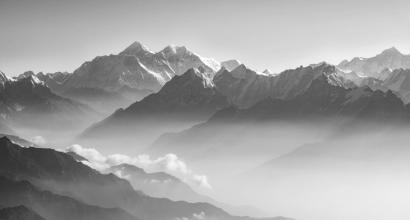Was dharma established?
When Arjuna said he would not fight, what did Svāmi say? He said, “I stand for upholding dharma. This war is for the sake of that. This war will not end if you do not fight. Before you could even think of it, I have already destroyed those who were against dharma” (“mayaivaite nihatāh pūrvameva ।)” — 11.33
Did it happen so?
It did, temporarily. “vināśāya ca duṣkṛtāṃ” — destruction of evil-doers — happened. After that, dhārmika kingdom was established. But it was of short duration, not permanent. Dharma cannot be sustained for a long time without being troubled. It is disturbed again and again, because of the imbalance of the three guṇas. Therefore Bhagavān has to incarnate again and again.
sambhavāmi yuge yuge।
-BG 4.8
The story of the universe does not end even if the story of the Mahābhārata is finished. The universe continues to exist. Man exists; so does his nature. These keep inflicting damage upon dharma. Therefore, a man established in dharma always has work to do. Just like daily baths and meals, the protection of dharma is a daily duty.
It seems that the daily ordeal of man is what Īśvara has in his mind to facilitate the order of the universe. Subjecting the resolution of man to trials and encouraging his sattva — this is the way of Īśvara’s grace. The three guṇas rub against one another; dharma is endangered because of that; human effort to fix the damage. In it is the elevation of the jīva and the fulfillment of its life.
Svakarma — svadharma
svakarmaṇā tam-abhyarcya।
-BG 18.46
Performing svakarma is itself worshipping the divine.
Performing svakarma is a part of one’s dharma. In svadharma, there are two parts : (1) One is just for the elevation of oneself — tapas, dhyana, vrata, etc., (2) The other is due to one’s affection to the world — satkarmas such as dāna and helping others.
Svakarma is when a person uses (a) his natural guṇas, energies, and wealth (b) for the benefit of the world related to him. One’s capability and the requirement of the society are both deciding factors for svakarma. Svadharma is to be established in svakarma.
From the below lines, it appears that this instruction is endorsed by F.H.Bradley, a famous western philosopher:
MY STATION AND ITS DUTIES
The self is to be realised as something not simply one or the other; it is to be realized further as will, wil not being merely the natural will, or the will as it happens to exit and finds itself here or there, but the will as the good will i.e., the will that realizes an end which is above this or that man, superior to them, and capable of confronting them is the shape of a law or an ought. This superior something, further, which is a possible law or ought to the individual man, does not depend for its existence on his choice or opinion. Either there is no morality, so says the moral consciousness, or moral duties exist independently of their position by this of that person : my duty may be mine and no other man’s, but I do not make it mine. If it is duty, it would be the duty of any person in my case and condition, whether he thought so or not : in a word, duty is ’objective’, in the sense of not being contingent on the mere opinion or choice of this or that subject.
What we have left then (to resume) is this—the end is the realization of the good will which is superior to ourselves; and again the end is the self-realization. Bringing these together, we see the end is the realization of ourselves as the will which is above ourselves. And this will (if morality exists) we saw must be ’objective’, because not dependent on ’subjective’ liking; and ’universal’, because not identifiable with any particular, but standing above all actual and possible particulars. Further, though universal, it is not abstract, since it belongs to its essence that it should be realized and it has no real existence except in and through its particulars. The good will (for morality) is meaningless, if, whatever else it be, it be not the will of living finite beings. pp. 161-162
To know what a man is (as we have seen) you must not take him in isolation. He is one of a people, he was born in a family, he lives in a certain society, in a certain state. What he has to do depends on what his place is, what his function is, and that all comes from his station in the organism. p. 173
Man is a social being ; he is real only because he is social, and can realize himself only because it is as social that he realizes himself. The mere individual is a delusion of theory; and the attempt to realize it in practice is the starvation and mutilation of human nature—p.174
Ethical Studies, Second Edition Essay V.
The inner thread of the oneness of the universe
What is the relationship between various objects and various happenings in the universe? What is the relationship between one jīva and another? What is the relationship between some karma and someone’s pleasure or pain? — Such questions are not relevant to a person studying the Gītā; because the whole universe is one single entity for him. It is an undivided lump or mass. Each aspect in this mass is connected to another. All of these are related to one another through Bhagavān.
mayi sarvam-idaṃ protaṃ sūtre maṇi-gaṇā iva ॥
-BG 7.7
The divine is the thread that links all. It can never be said of anything that it is not mine or that it is not related to me. Īśvara of the universe is a bird’s nest that does not have walls or barriers. Thousands and thousands of birds live there.
yatra viśvaṃ bhavaty-eka-nīḍam ॥
-Taittirīya Śruti, Āranyaka pariśiṣṭa, Anuvāka 1
Therefore, people belonging to all countries, races and states should live as one single family.
Connection between Bhagavadgītā and Rāmakathā
[The second series of the lecture series on the Bhagavadgītā finished on Wednesday, 8th May 1963. Its valedictory function happened on the morning of Sunday, 12th May 1963, as part of Vyāsapujā, Vedapārāyaṇa and other programs. This garland of verses was presented to the audience on that occasion.]
martyāti-martya-līlāya pṛthag-jīva-sva-bandhave ।
dharmādhi-dharma-gurave śrī-kṛṣṇāya namo namaḥ ॥1॥
To him, who sported as a human and beyond, a kinsman to each and every jīva, to the Guru of dharma[1] and far beyond[2], my obeisances to him, Bhagavān Śrīkṛṣṇa. (1)dharma-brahmādhvanya-guruṃ lokocchrāya-dhurandharam ।
naumi tattv-ānubhūtyarthaṃ śrī-vidyāraṇya-yoginam ॥ 2 ॥
To the guru in the ways of dharma and Brahma, to him who took upon himself the burden of elevating the world*, I pray and bow to him, Sri Vidyāraṇya-yogi to obtain the experience of the supreme tattva.śrīkṛṣṇa-bhagavadgītā jagajjīveśa-saṃhitā ।
jīyāt jīvita-sāphalya-mārga-anveṣibhir-arthitā ॥ 3 ॥
Victory to the Bhagavadgītā, bestowed by Śrīkṛṣṇa, a divine book about the inter-relationshop of jagat, jīva and Īśvara. It is sought by those who are on the quest for a fruitful life.gītā-tattvāvabodhārthaṃ śrīrāma-caritaṃ smaret ।
pūrvāvatāra-cāritrya-vyākhyā kṛṣṇoktir-eva hi ॥ 4 ॥
To understand the philosophy of the Gītā, we have to remember the story of ŚrRāma; because indeed, ŚrīKṛṣṇa’s words are the commentary of his conduct in the previous incarnation.gṛhī sannapi saṃnyāsa-carito bhūmijā-priyaḥ ।
niḥsaṅgaḥ karmaniṣṭho’pi samrāḍ-api na bhoga-dṛk ॥5॥
That beloved and lover of the daughter of Mother Earth was a saṃnyāsī even though he was a gṛhastha; he was unattached even though he performed karmas; he did not have hanker after enjoyment even though he was the emperor.sādhuḥ sarva-sakho’pyeṣa duṣṭānāṃ dauṣṭya-daṇḍanaḥ ।
yathā rājye tathā yuddhe jīva-sadgati-kārakaḥ ॥6॥
Śrīrāma was virtuous in his ways. He was friendly with everyone; but still he punished the wickedness of the wicked. He bestowed sadgati to people in the battle field and also by his benevolent rule.dhartuṃ vā rājya-padavīṃ tyaktuṃ vā sama-sammatiḥ ।
īśasvam-eva sarvasvaṃ rāghavo’gaṇayat sadā ॥ 7॥
Equally accepting to bear royal rank, and to give it up (he did not differentiate between the two); he considered his all to be the property of Īśvara.na bhayā-na yaśolābhān-naiva svargādy-apekṣayā ।
dharmāyaivācarat-dharmaṃ rāmaḥ sārvātmya-bhāvanaḥ ॥8॥
The dharmic conduct of Rāma was not due to fear (external fears like that of naraka, slander, etc); it was not due to love of fame or glory; nor was it to attain better worlds like svarga. He performed dharma for the sake of dharma. He was following a vow of sarvātma-bhāva - seeing oneself in all beings of the universe (described in the Gītā as sarva-bhūtastham ātmānam, etc).evam-eva ca sarve te rāma-bandhu-suhṛj-janāḥ ।
ṣvadharme sukham-āpannā bhogaiśvarya-parāṅmukhāḥ ॥9॥
Śrirāma’s friends and relatives did the same. They found pleasure in svadharma; and were detached from mundane pleasures and wealth.devī sītā lakṣmaṇaśca bharato mārutis-tathā ।
svārthaṃ vinā’rcayan devaṃ niyatāḥ sva-sva-karmabhiḥ ॥10॥
Mother Sītā, Lakṣmaṇa, Bharata and Āñjaneya worshipped Bhagavān by performing their svakarmas without even a hint of selfishness.
To be continued...
The present series is a modern English translation of DVG’s Kendra Sahitya Akademi Award-winning work, Bhagavad-gītā-tātparya or Jīvana-dharma-yoga. The translators wish to express their thanks to Śatāvadhāni R Ganesh for his valuable feedback and to Hari Ravikumar for his astute edits.
Footnotes
[1]For those under the influence of the three guṇas
[2]Beyond the three guṇas











































